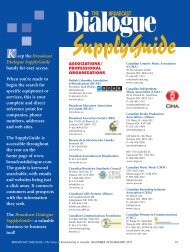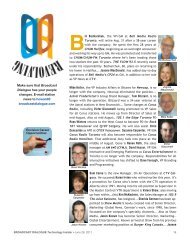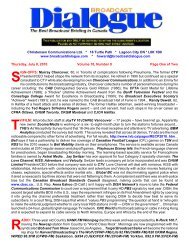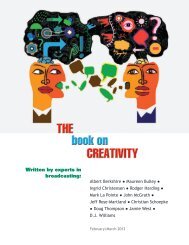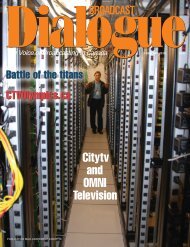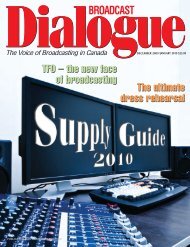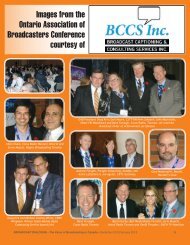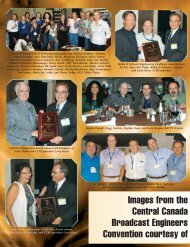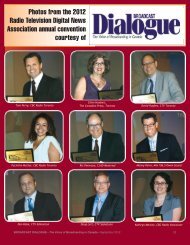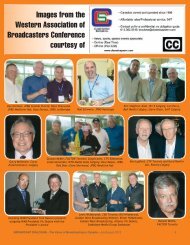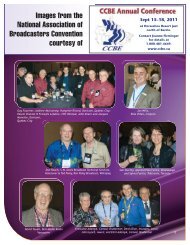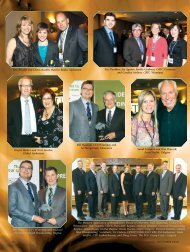Broadcast Dialogue
Broadcast Dialogue
Broadcast Dialogue
- No tags were found...
You also want an ePaper? Increase the reach of your titles
YUMPU automatically turns print PDFs into web optimized ePapers that Google loves.
ENGINEERINGImay have seen the future, and it mightbe called RT+.This column is for anyone that lamentsthe loss of DAB and its promise of“interactive radio”; that thinks the futureof radio is compromised by the Internet;that radio has been doomed by the iPod;or that just wants to play with radiobroadcast technology at the cutting edge,but doesn’t have a whole potful of moneyto spare for that purpose.We’ve talked before about how RDS/RBDS, that 25-year-old European technology,offers many interesting features, andhow it can be implemented with little efforton the broadcaster’s part. I’ve alwaysadmitted it could get expensive if you letyour imagination run free, but let’s faceit, you can get started for much less thana kilobuck, which is pretty negligible intoday’s broadcast equipment world.Why, curiously, is it already implementedin lots and lots of cars, but you’llbe hard-pressed to find even one aftermarketcar radio that has RDS? Why is thisfeature present in Europe, but hard to geta handle on here?Well, the folks that brought you RDSand RDBS have created a subset of thattechnology called Radiotext+ (RT+), and itjust might set music radio on its collectiveear. The latest versions of the iPod nano(the models that include an FM tuner) arealready equipped for it, and so is everymodel of Microsoft’s Zune player.It’s really simple, but quite elegant.Tag, you’re it!BY DAN ROACHRT+ inserts control codes in the littleusedRadiotext part of RDS which willallow identified subfields inside Radiotext.So you can insert playlist information, justlike with old RDS, but now the receivercan tell which text is the song title andwhich is the artist. More importantly, youcan insert song ID information (supertagging)which the iPod can rememberand which iTunes will later recognize andallow your listener to select for purchase,if they hear something they like.More importantly than that, Applewill know that the information came fromyour station, and might even pay you acommission for helping this whole processalong—participating U.S. stations aregetting 5% of each sale… this from whatis now the world’s largest music store.Most of us in broadcasting have longcontended that radio is the music company’sbest friend; that it introduces listenersto the music that they didn’t knowthey wanted to hear and that it causesmusic to be bought and sold. RT+ justmight prove that point.Okay, you’ve heard me prattle onabout something similar at some lengthwhen discussing IBOC. I still think it’s akiller application, but when’s the last timeyou saw anything IBOC happening aroundhere? This application has been liftedwholesale from the IBOC bag of tricksand placed on regular FM. It’s here rightnow and already implemented in thatnotorious radio-killer, the Apple iPod.Now, here come the caveats:RT+ is here right now. Software to programyour playlists into RT+ is here rightnow. You can get your playlists into yourlisteners’ iPods right now. No doubt youcan start “super-tagging” right now, butiTunes Canada doesn’t yet support it soyou won’t start getting those cheques forsales commissions this month—Applehas implemented it only in the U.S. sofar. But I wouldn’t bet against it arrivingreal soon, especially if you start buggingthem and indicating that your station isinterested.In the meantime, there are all thoseother field identifiers. With RDBS andRT+, you could be sending ski reports,weather information, teasers about what’scoming up on the station in the next fewminutes, very short news bulletins androad reports—anything you can think of.The only limitations are your imagination,and just how much effort you want topour into something that’s so brand new.Look for more information on taggingand Apple’s partnerships with U.S. broadcasterson the Apple iPod U.S. website.Descriptions of the RT+ enhancementsare freely available on the Internet, orin the manuals of the very latest RDBSencoders.Dan Roach works at S.W. Davis <strong>Broadcast</strong>Technical Services Ltd., a contractengineering firm based in Vancouver.He may be reached by e-mail atdan@broadcasttechnical.com.62 BROADCAST DIALOGUE—The Voice of <strong>Broadcast</strong>ing in Canada DECEMBER 2009/JANUARY 2010



